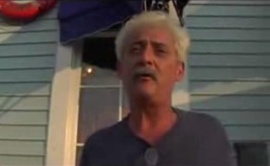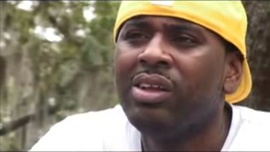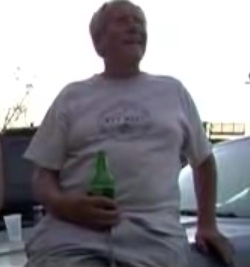"If it moved, you shot it:" Investigation details vigilante shootings in post-Katrina New Orleans
 In the chaotic weeks following Hurricane Katrina, as many as 30 residents of Algiers Point -- a predominantly white New Orleans neighborhood that emerged from the storm relatively unscathed -- stockpiled weapons and formed a vigilante group suspected of shooting as many as 11 African-American men while law enforcement authorities turned a blind eye and may have even stoked the violence.
In the chaotic weeks following Hurricane Katrina, as many as 30 residents of Algiers Point -- a predominantly white New Orleans neighborhood that emerged from the storm relatively unscathed -- stockpiled weapons and formed a vigilante group suspected of shooting as many as 11 African-American men while law enforcement authorities turned a blind eye and may have even stoked the violence.
Those are the explosive findings of "Katrina's Hidden Race War," a The Nation/ProPublica investigation by reporter A.C. Thompson, who spent 18 months interviewing surviving victims, gunmen and witnesses and examining government documents. In that story and a companion piece titled "Body of Evidence," he pieces together a shocking tale of brutality and injustice that has already sparked official concern.
"I am deeply disturbed by the reported incidents in Algiers Point, Louisiana following Hurricane Katrina," House Judiciary Committee Chair John Conyers (D-Mich.) said today. "I am particularly concerned about accounts that local police fueled, rather than extinguished, the violence."
 One of the shooting victims interviewed was Donnell Herrington (pictured right), who also told his story in Spike Lee's documentary "When the Levees Broke." Herrington, an armored-car driver, lived about a mile from Algiers Point in the predominantly black Algiers district, both of which lie across the Mississippi River from the French Quarter.
One of the shooting victims interviewed was Donnell Herrington (pictured right), who also told his story in Spike Lee's documentary "When the Levees Broke." Herrington, an armored-car driver, lived about a mile from Algiers Point in the predominantly black Algiers district, both of which lie across the Mississippi River from the French Quarter.
On Sept. 1, 2005, Herrington was headed to an official evacuation site at the Algiers Point ferry terminal with a cousin and a friend when he was blindsided by a shotgun blast to the neck that knocked him to the ground. As his companions tried to help him up, a second blast hit him from behind and also hit his cousin. The bleeding men managed to flee the scene while the gunmen -- three tattooed white males in their 30s or 40s -- yelled, "Get that nigger!"
Herrington eventually made his way to a hospital, where he was operated on for a potentially fatal torn jugular vein and other injuries. When he returned to New Orleans, he spoke with police only to discover there was no official report of his shooting -- and that no one was interested in taking one. To this day, the incident still has not been investigated. Thompson uncovered evidence of other shootings and even murders of black men in and around Algiers Point that have also gone without official investigation, even though vigilantes have openly admitted to shooting people after the storm.
 "It was great," Algiers Point resident Wayne Janak (pictured left) says in a video that accompanies the report. "It was like pheasant season in South Dakota. If it moved, you shot it." Nathan Roper (pictured at top) told Thompson, "The police said, If they're breaking in your property do what you gotta do and leave them [the bodies] on the side of the road." A woman who asked to remain anonymous reported that her uncle in New Orleans "was very excited that it was a free-for-all -- white against black -- that he could participate in." She also told of a cousin who e-mailed her a photo in which he posed next to a black man who had been fatally shot -- a modern-day version of the chilling photographs once popular as souvenirs of lynchings.
"It was great," Algiers Point resident Wayne Janak (pictured left) says in a video that accompanies the report. "It was like pheasant season in South Dakota. If it moved, you shot it." Nathan Roper (pictured at top) told Thompson, "The police said, If they're breaking in your property do what you gotta do and leave them [the bodies] on the side of the road." A woman who asked to remain anonymous reported that her uncle in New Orleans "was very excited that it was a free-for-all -- white against black -- that he could participate in." She also told of a cousin who e-mailed her a photo in which he posed next to a black man who had been fatally shot -- a modern-day version of the chilling photographs once popular as souvenirs of lynchings.
Color of Change, a national racial justice advocacy group, has launched a campaign calling on Louisiana Gov. Bobby Jindal, state Attorney General Buddy Caldwell and the U.S. Justice Department to investigate the shootings. Meanwhile, The Nation has asked Conyers and Sen. Patrick Leahy (D-Vt.) to use their subpoena power to order testimony from former New Orleans Police Chief Eddie Compass, former District Attorney Eddie Jordan, the police officers posted in Algiers Point after Katrina, and the vigilantes themselves.
"If we as a nation are ever truly to transcend race," the editorial concludes, "tolerance for racist violence in our midst must come to an end."
(Photo stills from the companion video to The Nation's report)
Tags
Sue Sturgis
Sue is the former editorial director of Facing South and the Institute for Southern Studies.
